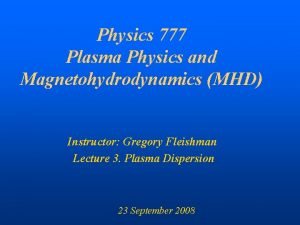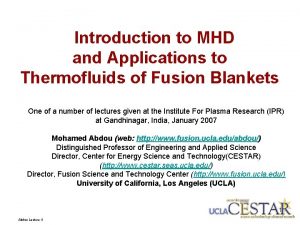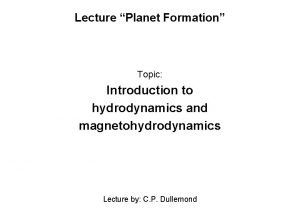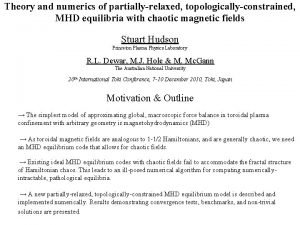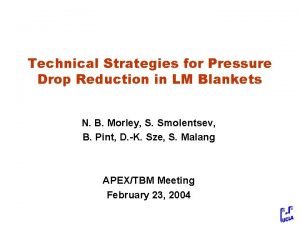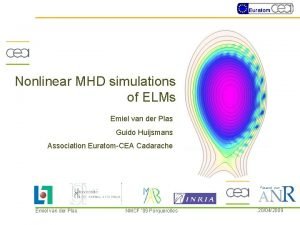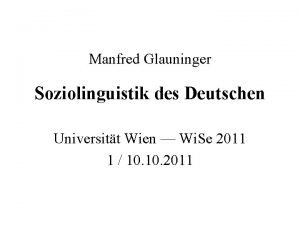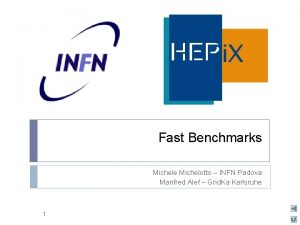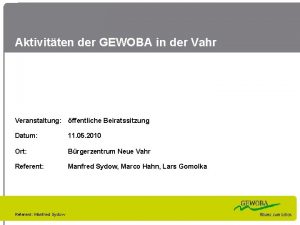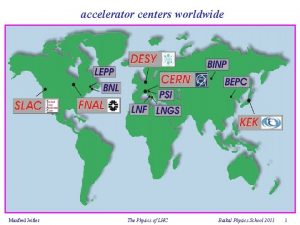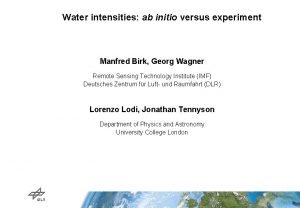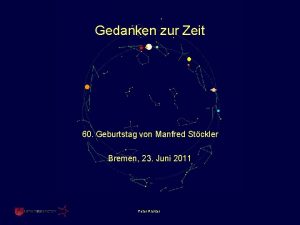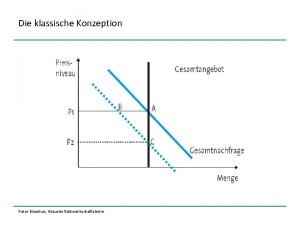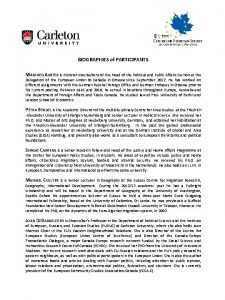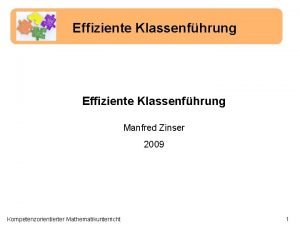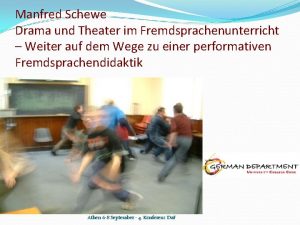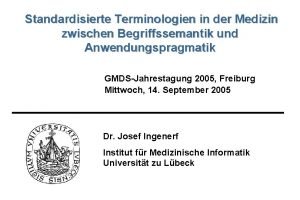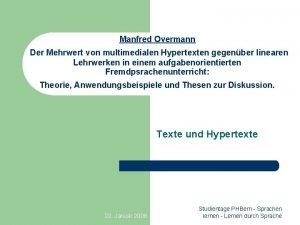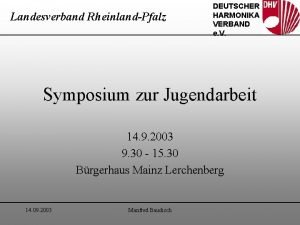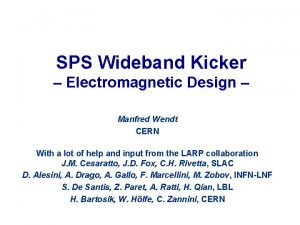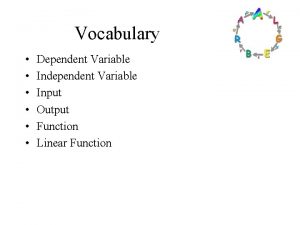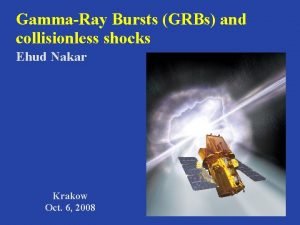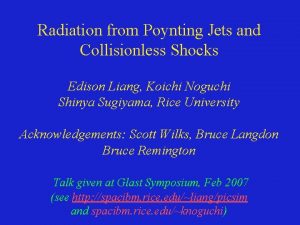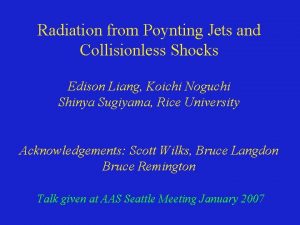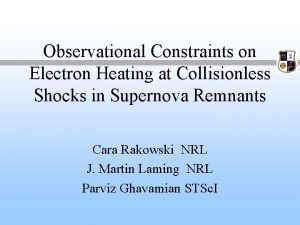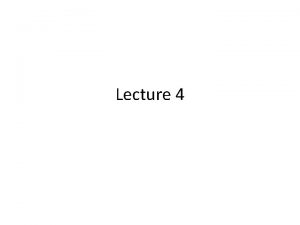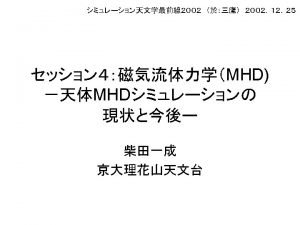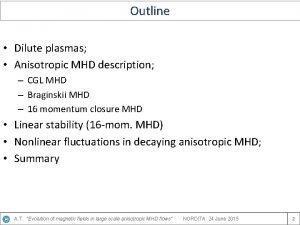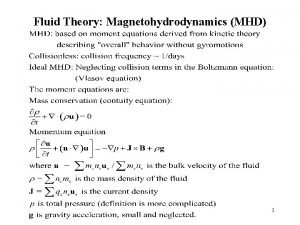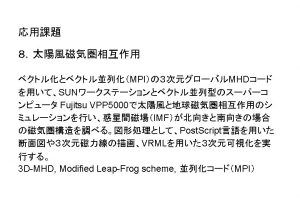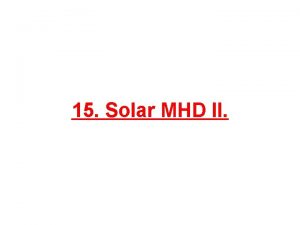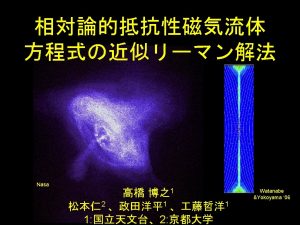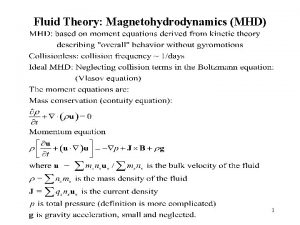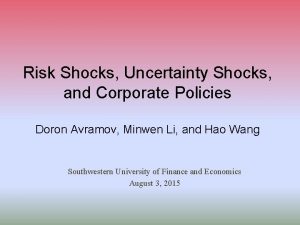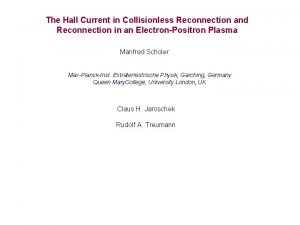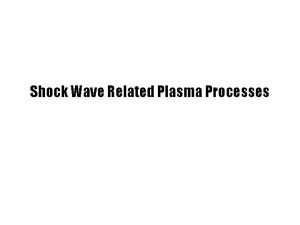MHD Shocks and Collisionless Shocks Manfred Scholer MaxPlanckInstitut




























































- Slides: 60

MHD Shocks and Collisionless Shocks Manfred Scholer Max-Planck-Institut für extraterrestrische Physik Garching, Germany The Solar/Space MHD International Summer School 2011 USTC, Hefei, China, 2011

Overview 1. Information, Nonlinearity, Dissipation 2. Shocks in the Solar System 3. MHD Rankine – Hugoniot Relations 4. de Hoffmann-Teller Frame, Coplanarity, and Shock Normal Determination 5. Resistive, 2 -Fluid MHD – First Critical Mach Number 6. Specular Reflection of Ions: Quasi-Perpendicular vs Quasi-Parallel Shocks 7. Upstream Whistlers and the Whistler Critical Mach Number 8. Brief Excursion on Shock Simulation Methods 9. Quasi-Perp. Shock: Specular Reflection, Size of the Foot, Excitation of Alfven Ion Cyclotron Waves 10. Cross- Shock Potential and Electron Heating 11. Quasi-Parallel Shock: Upstream Ions, Ion-Ion Beam Instabilities, and Interface Instability

12. The Bow Shock Electrons at the Foreshock Edge Field-Aligned Beams Diffuse Ions Brief Excursion on Diffusiv Acceleration Large-Amplitude Pulsations

Literature D. Burgess: Collisionless Shocks, in Introduction to Space Physics, Edt. M. G. Kivelson & C. T. Russell, Cambridge University Press, 1995 W. Baumjohann & R. A. Treumann: Basic Space Plasma Physics, Imperial College Press, 1996

Object in supersonic flow – Why a shock is needed If flow sub-sonic information about object can transmitted via sound waves against flow Flow can respond to the information and is deflected around obstacle in a laminar fashion If flow super-sonic signals get swept downstream and cannot inform upstream flow about presence of object A shock is launched which stands in upstream flow and effetcs a super- to sub-sonic transition The sub-sonic flow behind the shock is then capable of being deflected around the object


Fluid moves with velocity v; a disturbance occurs at 0 and propagates with velocity of sound c relative to the fluid The velocity of the disturbance relative to 0 is v + c n, where n is unit vector in any direction (a) v<c : a disturbance from any point in a sub-sonic flow eventually reaches any point (b) v>c: a disturbance from position 0 can reach only the area within a cone given by opening angle 2 a, where sin a =c / v Surface a disturbance can reach is called Mach‘s surface

Ernst Mach

Examples of a Gasdynamic Shock ‘Schlieren‘ photography

More Examples Shock attached to a bullet Shock around a blunt object: detached from the object (blunt = rounded, not sharp))

Schematic of how a compressional wave steepens to form a shock wave (shown is the pressure profile as a function of time) The sound speed is greater at the peak of the compressional wave where the density is higher than in front or behind of the peak. The peak will catch up with the part of the peak ahead of it, and the wave steepens. The wave steepens until the flow becomes nonadiabatic. Viscous effects become important and a shock wave forms where steepening is balanced by viscous dissiplation.


Characteristics cross at one point at a certain time Results in 3 -valued solution

Add some physics: Introduce viscosity in Burgers‘ equation

MHD In MHD (in addition to sound wave) a number of new wave modes (Alfven, fast, slow) Background magnetic field, v x B electric field We expect considerable changes Solar System Solar wind speed 400 – 600 km/sec Alfven speed about 40 km/sec: There have to be shocks


Interplanetary traveling shocks Coronal Mass Ejection (SOHO-LASCO) in forbidden Fe line Large CME observed with SOHO coronograph


Quasi-parallel shock Quasi-perpendicular shock

Vsw N B Belcher and Davis 1971

Corotating interaction regions and forward and reverse shock

CIR observed by Ulysses at 5 AU 70 ke. V 12 Me. V R F Decker et al. 1999

Earth‘s bow shock

The Earth‘s Bow Shock Quasi-Parallel Shock solar wind 300 -600 km/s Perpendicular Shock

Magnetic field during various bow shock crossings

Heliospheric termination shock Schematic of the heliosphere showing the heliospheric termination shock (at about 80 – 90 AU) and the bow shock in front of the heliosphere.

Voyager 2 at the termination shock (84 AU)


Friedrichs-diagram

Rankine – Hugoniot Relations William John Macquorn Rankine 1820 - 1872 Pierre-Henri Hugoniot 1851 - 1887





2 1 F h h t n












Oblique MHD Shocks




Fast Slow Intermediate Switch-on Switch-off Rotational


de Hoffmann-Teller Frame (H-T frame) and Normal Incidence Frame (NIF frame) Unit vectors Incoming velocity Subtract a velocity v. HT perp to normal so that incoming velocity is parallel to B






This is widely used in order to determine the shock normal from magnetic field observations

Adiabatic reflection (conservation of the magnetic moment) Note: only predicts energy of reflected ions, not whether an ion will be reflected
 What are some of the things bob ewell starts doing?
What are some of the things bob ewell starts doing? Disadvantages of mhd generator
Disadvantages of mhd generator Fsae shocks
Fsae shocks Aggregate of chapter 6
Aggregate of chapter 6 Mhd alyssa
Mhd alyssa Predominant cell type
Predominant cell type Introduction to mhd
Introduction to mhd Mhd titel
Mhd titel Mhd equations
Mhd equations Mhd
Mhd Mhd lm
Mhd lm Mhd
Mhd Manfred harth
Manfred harth Manfred glauninger
Manfred glauninger Manfred touron projects
Manfred touron projects Fast benchmarks
Fast benchmarks Manfred hanglberger
Manfred hanglberger Manfred doepp
Manfred doepp Manfred sydow
Manfred sydow Manfred jeitler
Manfred jeitler Manfred birk
Manfred birk Manfred horr
Manfred horr Manfred huber
Manfred huber Site:slidetodoc.com
Site:slidetodoc.com Manfred makiolla
Manfred makiolla Planetenbewegung simulation
Planetenbewegung simulation Angebotsorientierte konzeption
Angebotsorientierte konzeption Manfred auster
Manfred auster Rituale mathematikunterricht
Rituale mathematikunterricht Manfred thielen
Manfred thielen Manfred scherbaum
Manfred scherbaum Manfred maute
Manfred maute Dialog drama musikal
Dialog drama musikal Manfred huber rate my professor
Manfred huber rate my professor Manfred van wetten spedition niederlande
Manfred van wetten spedition niederlande Hannah scherer
Hannah scherer Bildungsprinzipien
Bildungsprinzipien Neesmax
Neesmax Manfred overmann
Manfred overmann Deutscher harmonika verband
Deutscher harmonika verband Urogynäkologie wien
Urogynäkologie wien Manfred freinschlag
Manfred freinschlag Manfred wendt
Manfred wendt Manfred huber
Manfred huber Manfred tietz
Manfred tietz Red, orange, yellow, green, blue, purple
Red, orange, yellow, green, blue, purple And because i am happy and dance and sing
And because i am happy and dance and sing Comparison chart romeo and juliet vs. west side story
Comparison chart romeo and juliet vs. west side story Tall old people
Tall old people Read and write pesos and centavos in words and symbols
Read and write pesos and centavos in words and symbols Red orange yellow green blue indigo violet pink
Red orange yellow green blue indigo violet pink Your teacher is giving you a test worth 100 points
Your teacher is giving you a test worth 100 points Young and dyslexic past paper
Young and dyslexic past paper What did the sibley commission do
What did the sibley commission do West yorkshire health and care partnership
West yorkshire health and care partnership Compare and contrast transverse and longitudinal waves
Compare and contrast transverse and longitudinal waves Compare and contrast spring tides and neap tides.
Compare and contrast spring tides and neap tides. Input independent variable
Input independent variable Lesson 5 verbs action (transitive/intransitive) answer key
Lesson 5 verbs action (transitive/intransitive) answer key What are life roles?
What are life roles? Role of nurse in maintenance of records and reports
Role of nurse in maintenance of records and reports




